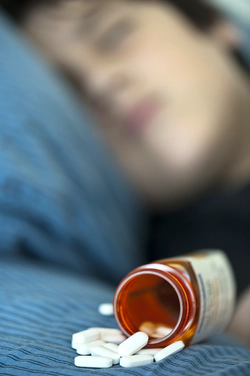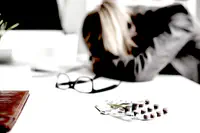Prescription Stimulants and Sedatives Pose Severe Risks for Young People
New information shows that young people are increasingly overdosing on prescription drugs, namely psychotropic medications such as benzodiazepines and prescription stimulants.

It is the goal of any parent to ensure a good upbringing for their children, to do everything they can to make sure their kids have everything they need to lead a happy, long, and successful life. Unfortunately, young people are increasingly being exposed to mind-altering drugs. Parents try to combat this, but when the drugs that lead to an overdose are doctor-recommended prescription psychotropics, parents may feel at a loss as to how to protect their children.
What are Prescription Stimulants and Depressants?
Prescription stimulants are mind-altering pharmaceutical drugs used to treat attention-deficit hyperactivity disorder (ADHD). They are also used to treat narcolepsy (uncontrollable episodes of deep sleep). Prescription stimulants are supposed to increase alertness, attention, and energy. Examples of prescription stimulants include:
- Dexedrine
- Adderall
- Ritalin
- Concerta
Prescription depressants are mind-altering pharmaceutical drugs generally used to treat anxiety or insomnia. Such drugs slow down activity in the brain and spinal cord. These drugs are often referred to as benzodiazepines. Examples of depressants include:
- Alprazolam
- Clonazepam
- Diazepam
- Estazolam
- Lorazepam
There are other prescription depressants that don’t qualify as benzodiazepines, such as barbiturates and certain sleep medications.
New Findings Indicate Young People at Risk

A new study found that young adults are increasingly dying from overdoses on prescription drugs, even when prescribed those drugs by a doctor.1 According to the findings, benzodiazepines like Xanax and stimulants like Adderall accounted for more than 700 and 900 deaths, respectively, among young people in 2019.
People must remember that taking mind-altering prescription drugs is not without risk, even when done as medically directed. Dr. Mark Olfson, the senior researcher in the study, stated, “In recent years, there has been considerable attention devoted to risks of addiction associated with diverted or illicitly obtained benzodiazepines and stimulants.2 The new study serves as a reminder that prescription benzodiazepines and stimulants also pose overdose risks to the patients who are prescribed them.”
To accurately assess the public health problem, researchers gathered data on youths aged 15 to 24 who were seen in emergency rooms for overdosing on benzodiazepines or stimulants from 2016 through 2018. The researchers found that 29% of the youths who overdosed on benzodiazepines and died as a result had been given a doctor’s prescription for the drugs in the last six months. Approximately 25% of the youths who overdosed on stimulants and died as a result had been given a doctor’s prescription for the drugs in the last six months.
“Overdose deaths for 15- to 24-year-olds increased between 2019 and 2020 by almost 50%, and the rate of drug overdose deaths has been steadily increasing.”
It’s also important to note that prescription stimulants and depressants aren’t the only drugs leading to a spike in overdose deaths. This is a nationwide problem involving several drug types and all age demographics. Pat Aussem at the Partnership to End Addiction in New York City stated, “This has been the deadliest year on record, as we’ve experienced over 100,000 overdose deaths in our country—the highest it’s ever been. Teens and young adults haven’t been spared. Overdose deaths for 15- to 24-year-olds increased between 2019 and 2020 by almost 50%, and the rate of drug overdose deaths has been steadily increasing.”2
Opioid Involvement in Overdoses
Many of the overdose deaths cited above also involved opioids, adding another layer of urgency to the need to address the problem. According to the researchers, young people who die from drug overdoses often die due to using multiple drugs at once. And if opioids and another drug are found in their system at the time of death, the other drug will likely be a prescription stimulant or depressant.1
The severity of this growing problem cannot be stressed enough. According to a new report, young Americans have lost about 1.5 million years of potential life due to drug overdoses in recent years. The authors of this study highlight the problem with these statistics, “Over the 5-year period of this cross-sectional study, adolescents experienced nearly 200,000 YLL [Years of Life Lost], and young people amassed greater than 1.25 million YLL.3 Male adolescents and young people accounted for substantially greater unintentional drug overdose mortality (YLL and incident deaths) than female adolescents and young people.” Few things are more tragic than thousands of American youths losing millions of years of potential life due to fatal overdoses, hence the urgent need to ensure young people receive addiction treatment.
Treatment Provides an Effective Way Out of Addiction

Drug and alcohol addiction is a life or death problem for all who experience it. It is a crisis that leads to tens of thousands of lives lost every year. When young people die because of drug overdoses–lives snuffed out long before their time–an additional layer of sorrow is added to the tragedy. That’s why it is important to ensure that loved ones who struggle with drugs get help from qualified drug rehab centers.
It’s not enough for parents of adolescents and young adults to make sure their kids don’t use street drugs or alcohol. Even prescription drugs can be dangerous, addictive, mind-altering, and fatal. If you know someone who is misusing pharmaceutical drugs, even if they have a prescription, make sure that person gets help at a drug rehab center immediately. Don’t let them become a statistic.
Sources:
-
Greta Bushnell, Hillary Samples, Tobias Gerhard, Diane P. Calello, Mark Olfson. “Benzodiazepine and Stimulant Prescriptions Before Overdose in Youth.” 2022, Pediatrics Article ↩︎ ↩︎
-
US News. “Some Teens Are Overdosing With Meds Prescribed for ADHD, Anxiety.” 2022, US News Article ↩︎ ↩︎
-
O. Trent Hall, DO; Candice Trimble, BA; Stephanie Garcia, BA; et al. “Unintentional Drug Overdose Mortality in Years of Life Lost Among Adolescents and Young People in the US From 2015 to 2019.” 2022, JAMA Pediatrics Research Letter ↩︎







 ®
®